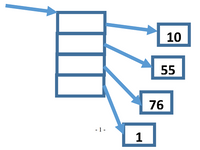
Topic: pointers, dynamic array and command line arguments
Write a function named "getDynamicNumList" that accepts a count (integer) for the total
of all the numbers to obtain storage for.
The function will allocate an array of integer pointers dynamically,
then read in from the user that many numbers.
For each number, it will allocate memory for each integer initialized it with what the user
enters and save its pointer in the new array.
It then returns the pointer of the array of integer pointers to the caller.
The caller should print out this array based on that description.
Here is an example of calling getDynamicNumList with 4.
It will allocate an array of 4 pointers and read in 10, 55, 76 and 1.
Each integer will have its own dynamic memory location.

Trending nowThis is a popular solution!
Step by stepSolved in 3 steps with 1 images

- struct remove_from_front_of_vector { // Function takes no parameters, removes the book at the front of a vector, // and returns nothing. void operator()(const Book& unused) { (/// TO-DO (12) ||||| // // // Write the lines of code to remove the book at the front of "my_vector". // // Remember, attempting to remove an element from an empty data structure is // a logic error. Include code to avoid that. //// END-TO-DO (12) /||, } std::vector& my_vector; };arrow_forwardwrite this using java script arrow functions -thank you :)arrow_forwardAHPA #10:The Secure Array(use C programming)• A programmer that you work with, Peter, is a jerk.• He is responsible for an array [theArray] that is a key part of an importantprogram and he maintains a sum of the array values at location [0] in the array.• He won't give you access to this array; however, your boss has told you that youneed to get input from the user and then place it into the array.• Each evening Peter will scan the code and remove any illegal references to hisarray.• Using pointers, access Peter's array without him knowing it and place threevalues that you got from the user (101, 63, 21) at locations 3, 6, and 9.Recalculate the sum value and update it. ( the output should be same as the picture)arrow_forward
- Write three functions for: mean, remove, display //include any standard libraries needed // - passes in an array along with the size of the array // - returns the mean of all values stored in the array double mean( const double array [ ], int arraySize); // - Passes in an array, the size of the array by reference, and the index of a value to be removed from the array. // - Removes the value at this index by shifting all of the values after this value up, keeping the same relative order of all values not removed. // - Refuces arraySize by 1. void remove (double array[], not &arraySize, int index); // - Passes in an array and the size of the array. // - outputs each value in the array separated by a comma and space, with mo comma, space or beeline at the end. void display (const double array[], int arraySize); const int ARR_CAP = 100; int main (int argc, char *argv[]){// verify file name provided on command line // open file and verify it opened // declare an array of doubles of…arrow_forwardAssume the following main module is in a program that includes the binarysearch function that was shown in a chapter. Why doesn't the pseudocode in the main module work?arrow_forward1- Write a user-defined function that accepts an array of integers. The function should generate the percentage each value in the array is of the total of all array values. Store the % value in another array. That array should also be declared as a formal parameter of the function. 2- In the main function, create a prompt that asks the user for inputs to the array. Ask the user to enter up to 20 values, and type -1 when done. (-1 is the sentinel value). It marks the end of the array. A user can put in any number of variables up to 20 (20 is the size of the array, it could be partially filled). 3- Display a table like the following example, showing each data value and what percentage each value is of the total of all array values. Do this by invoking the function in part 1.arrow_forward
 Computer Networking: A Top-Down Approach (7th Edi...Computer EngineeringISBN:9780133594140Author:James Kurose, Keith RossPublisher:PEARSON
Computer Networking: A Top-Down Approach (7th Edi...Computer EngineeringISBN:9780133594140Author:James Kurose, Keith RossPublisher:PEARSON Computer Organization and Design MIPS Edition, Fi...Computer EngineeringISBN:9780124077263Author:David A. Patterson, John L. HennessyPublisher:Elsevier Science
Computer Organization and Design MIPS Edition, Fi...Computer EngineeringISBN:9780124077263Author:David A. Patterson, John L. HennessyPublisher:Elsevier Science Network+ Guide to Networks (MindTap Course List)Computer EngineeringISBN:9781337569330Author:Jill West, Tamara Dean, Jean AndrewsPublisher:Cengage Learning
Network+ Guide to Networks (MindTap Course List)Computer EngineeringISBN:9781337569330Author:Jill West, Tamara Dean, Jean AndrewsPublisher:Cengage Learning Concepts of Database ManagementComputer EngineeringISBN:9781337093422Author:Joy L. Starks, Philip J. Pratt, Mary Z. LastPublisher:Cengage Learning
Concepts of Database ManagementComputer EngineeringISBN:9781337093422Author:Joy L. Starks, Philip J. Pratt, Mary Z. LastPublisher:Cengage Learning Prelude to ProgrammingComputer EngineeringISBN:9780133750423Author:VENIT, StewartPublisher:Pearson Education
Prelude to ProgrammingComputer EngineeringISBN:9780133750423Author:VENIT, StewartPublisher:Pearson Education Sc Business Data Communications and Networking, T...Computer EngineeringISBN:9781119368830Author:FITZGERALDPublisher:WILEY
Sc Business Data Communications and Networking, T...Computer EngineeringISBN:9781119368830Author:FITZGERALDPublisher:WILEY





